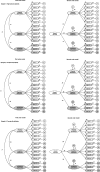Psychometric properties of the Shirom-Melamed Burnout Measure (SMBM) among adolescents: results from three cross-sectional studies
- PMID: 30144799
- PMCID: PMC6109266
- DOI: 10.1186/s12888-018-1841-5
Psychometric properties of the Shirom-Melamed Burnout Measure (SMBM) among adolescents: results from three cross-sectional studies
Abstract
Background: Burnout has long been understood as work-related physical, emotional, and cognitive exhaustion. However, burnout symptoms can also be found among younger people, including school-aged adolescents. While the Shirom-Melamed Burnout Measure (SMBM) is a widely applied instrument, its psychometric properties have not yet been investigated in adolescent populations. We therefore examined the psychometric properties of the SMBM in three independent samples of adolescents.
Methods: In total, 249 high school students, 144 vocational students, and 257 adolescent elite athletes completed the SMBM, along with questionnaires related to perceived stress, depressive symptoms, and life satisfaction. Descriptive statistics, gender differences, and internal consistency, convergent/discriminant validity, and factorial validity (including measurement invariance across genders) were examined in each sample.
Results: The SMBM had adequate internal consistency. Confirmatory factor analyses showed that both a first- and second-order model achieve good model fit. Moreover, evidence for sufficient convergent and discriminant validity was found. Finally, in two of the three samples, female adolescents reported higher SMBM scores.
Conclusions: The SMBM has been widely used in international burnout research. However, this is the first study providing empirical evidence that the SMBM has acceptable psychometric properties and satisfactory convergent/discriminant and factorial validity among young people. The SMBM is a concise and economic tool to assess self-rated symptoms of burnout, and presents a valuable alternative to existing school burnout inventories. In particular, the SMBM can facilitate the investigation of the transition of young people from school to working life.
Keywords: Burnout; Measurement invariance; Mental wellbeing; Stress; Validity.
Conflict of interest statement
Authors’ information
Markus Gerber is assistant professor of sport science at the Department of Sport, Exercise and Health at the University of Basel, Switzerland. Manuel Mücke and René Schilling are PhD students in the Division of Sport and Psychosocial Health at the at the Department of Sport, Exercise and Health at the University of Basel, Switzerland. Flora Colledge is a post-doctoral researcher in the Sport Science Section at the at the Department of Sport, Exercise and Health at the University of Basel, Switzerland. Serge Brand is a senior researcher in the Sport Science Section at the Department of Sport, Exercise and Health at the University of Basel, Switzerland. He also works as a senior researcher and clinical psychologist at the Center for Affective, Stress and Sleep Disorders, Psychiatric Clinics of the University of Basel, Basel, Switzerland. Finally, he is a visiting professor at Kermanshah University of Medical Sciences (KUMS), Substance Abuse Research Center and Sleep Disorders Research Center; Kermanshah, Iran. Sebastian Ludyga is a post-doctoral researcher in the Sport Science Section at the at the Department of Sport, Exercise and Health at the University of Basel, Switzerland.
Ethics approval and consent to participants
Ethics approval has been obtained for all three studies before data assessment from the local ethical review board (Ethical Review Board of Northwestern and Central Switzerland, EKNZ). All participants have provided written informed consent.
Consent for publication
Not applicable.
Competing interests
The authors declare that they have no competing interests.
Publisher’s Note
Springer Nature remains neutral with regard to jurisdictional claims in published maps and institutional affiliations.
Figures


References
-
- Schaufeli W, Leiter MP, Maslach C. Burnout: 35 years of research and practice. Career Dev Int. 2009;14:204–220. doi: 10.1108/13620430910966406. - DOI
-
- Kristensen TS, Borritz M, Villadsen E, Christensen KB. The Copenhagen burnout inventory: a new tool for the assessment of burnout. Work Stress. 2005;19:192–207. doi: 10.1080/02678370500297720. - DOI
-
- Maslach C, Jackson SE, Leiter MP. Maslach burnout inventory manual. Palo Alto: Consulting Psychology Press; 1996.
-
- Schaufeli WB, Taris TW. The conceptualization and measurement of burnout: common ground and worlds apart. Work Stress. 2005;19:256–262. doi: 10.1080/02678370500385913. - DOI
Publication types
MeSH terms
LinkOut - more resources
Full Text Sources
Other Literature Sources
Medical

